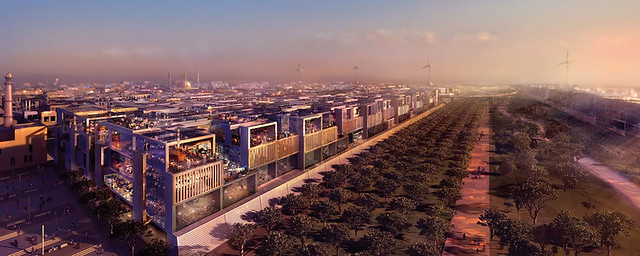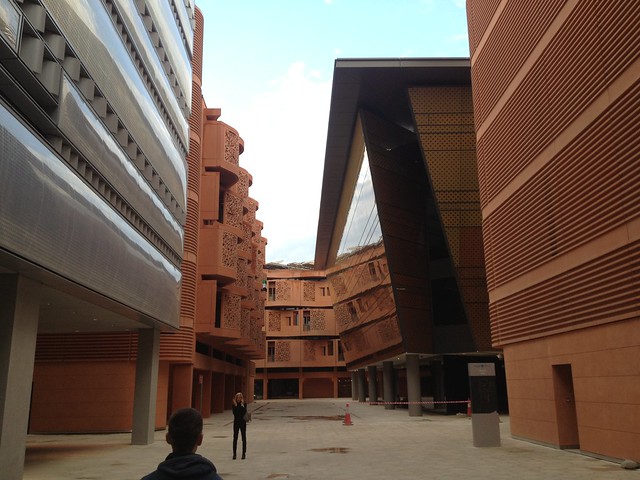MASDAR CITY — They appear like a mirage in the Gulf desert. A few yellow and silver futuristic buildings, "embroidered" ocher facades, a triangular metal lighthouse, solar panels for as far as the eye can see. Many people come to this modern oasis 30 kilometers from Abu Dhabi like they would go to Disneyland — with a map of the "attractions" in hand.
It's also from this capital of the United Arab Emirates (UAE) that the Solar Impulse plane departed March 9 for its flight around the world. Its designers Bertrand Piccard and André Borschberg were invited there by the emirs and sponsored by Masdar, the company that manages the eponymous city.
Their adventure will also be used to illustrate that clean technologies already exist to develop a "green" future everywhere. We just need to apply them. In theory. Because Masdar City, the project that was supposed to put this theory into practice, has become a reality check. Some see the town like a promising example of sustainable city planning — Masdar means "the source." For others, it's an error of vision a wannabe eco-city that is still a long way from realizing the avant-garde plans that were revealed in 2006.
The ambition was huge: to build a zero-carbon town, even producing renewable energies, and generating no non-recyclable garbage. "This vision was set by Abu Dhabi's ruling family," says Chris Wan, the Masdar design manager. The founder of the UAE, the late Sheikh Zayed bin Sultan Al Nahyan, "never stopped asking his people to respect the environment," he says.
The one that Wan characterizes as the "wisest Arab" also made his country prosper by creating refineries and desalination plants in the desert. The ecological footprint per inhabitant (25 tons of carbon per year) is the third in the world. But in the 2000s, the Emiratis noted that their gas and oil reserves would run out within 150 years. They decided to bank on renewable energies and their testing. Masdar City, a $22 billion city, was to be the showcase of this wish.

Masdar City rendering — Source: Norman Foster/Forgemind ArchiMedia
The six square kilometer eco-city, designed by Norman Foster's architecture firm, was set to be completed in 10 years. Self-sufficient in energy, a place of life and technological activity, the goal was to attract 1,500 multinational and start-up companies. The city was aiming to have 50,000 residents and 40,000 commuters by 2020.
By 2008, the heart of the project was complete: about 15 buildings housing the Masdar Institute as well as accommodation for its 500 students. The streets are all pedestrian and therefore very quiet, also allowing the buildings to be very close to each other.
"Everything has been carefully planned," Wan explains. The walls absorb little heat, so they release only a little in the evening. Reduced window surfaces are covered with automatic fixed or mobile louvered shutters. The streets face into the wind, with an installation on the main square of a modern vision of the "windcatcher," a device invented by the Persians to catch air circulating above the city and redirect it towards the ground.
"It works so well that when it's 5°C in the streets of Abu Dhabi, the perceived temperature is at least 10° cooler in Masdar," says development chief Stephen Severance.
Inside, everything has been thoroughly planned to reduce the consumption of energy and water. There are also motion detectors with grouped optimization of the various electric and energy networks. "A way to save 30% to 40% in energy compared to the usual building, where air conditioning requires lots of energy," Wan says.
Trouble in paradise
But 2008 also brought the global financial crisis. Because Abu Dhabi had to help Dubai financially, all its budgets were revised. Masdar City's budget was reduced to $18 billion, and the completion date pushed to 2015, at the earliest. The housing market has crumbled, and not a single block of houses is being built here. Nobody wants to come and live in this concept city anymore, which, is close to the airport. The multinational companies never came, nor have the start-ups.

Alone in Masdar City — Photo: stuart.childs
And other, more technical problems have also emerged. The complex, technical systems have been reevaluated, and the new plan is to build a solar panel farm on the outskirts of the city. Unfortunately, these lack efficiency because the desert dust covers them. "And because of a whitish fog that fills the air, solar irradiance is 20% less than expected rates," says Matteo Chiesa, a nanotechnology professor. "As a result, solar energy is more expensive."
Meanwhile, the water desalination circuits that were supposed to use this green energy have been re-measured.
These difficult years give the Masdar City supervisors time to question themselves. But they think positively. "We're making less progress than expected," Severance admits. "But like flying to the Moon, once the goal was set, what would it have changed if it had been reached in 1975 and not in 1969? The important thing is that we build the first sustainable city in a difficult environment. The crisis might have done us a favor. Without it, we would have built massively, but what is the least sustainable thing in the world: buildings that would have remained empty."
So they revised the building strategy. No more speculation and a green light on building construction only when it has been 80% funded. "This makes it more difficult to convince interested clients," Wan admits. "But the advantage for companies that move hundreds of people around, such as Siemens, is to take part in the design of the building so it meets their needs."

Construction site in Masdar City — Photo: Shannon Dosemagen
With the International Renewable Energy Agency (Irena), which has built its headquarters a few streets away, the German company Siemens is one of the first to have established itself in the eco-city — in exchange for juicy contracts in the country, observers note. A few similar projects are underway," Wan says.
After hiring several foreign researchers, the Masdar Institute, set up in collaboration with Boston's MIT, achieved recognition. "The first students leave with a diploma validated by both schools," says Ken Volk, public relations chief. "Investment structures favor the blooming of start-ups, of which there are already four," adds Bruce Ferguson.
Tweaking the dream
This pragmatism also influences other areas that gave Masdar City its futuristic glow. The city was supposed to be built on stilts so that the personal rapid transit could navigate. This system still exists only in its demonstration form, but it will probably not be extended. Simple electric cars will probably be used instead.
Originally, the city was to follow the energetic consumption of every resident in detail — a notion called "personalized carbon footprint," but that too has been scrapped. "We came back on that for ethical reasons," says Andreas Henschel, a German computer science professor. As for his colleague Matteo Chiesa, he still thinks it would have been a "fantastic opportunity" to test this concept.
But Wan says that "the first rentals, 500 apartments, schools and supermarkets will be built shortly." Still, Jean-Jacques Rousseau was right: "Houses make a town, but citizens make a city."





